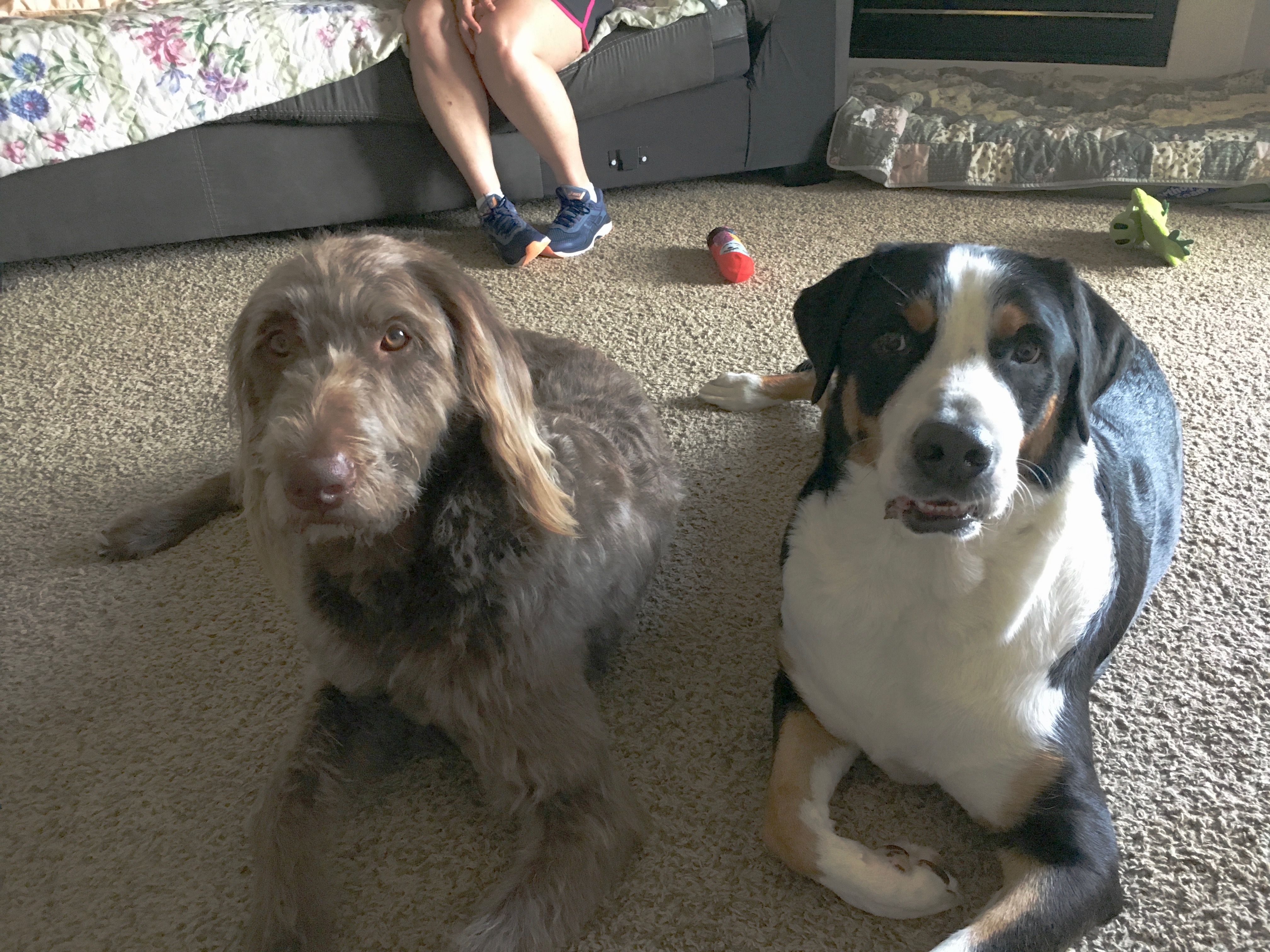Teaching a Dog to Wait at the Door to Develop Self Control and Confidence
By: David Codr
Published Date: July 9, 2018
For this Bellevue dog training session we helped a pair of anxious dogs (Abner, left, a 2 year-old Labradoodle and his roomie, Hazel, a 3 year-old Greater Swiss Mountain Dog) develop some control and build up their confidence to stop them from reacting aggressively towards guests and people they don’t know.
Knowing that I was going to meet a pair of anxious dogs, I called ahead and had the guardian put Hazel in another room so I could meet Abner without the energy of another nervous dog. Abner barked and paced around in the minute after I arrived so I took him out for a quick walk.
Dogs get over things by literally moving forward and as a dog behaviorist, I have found that meeting a scared dog outside can help it feel more comfortable. There is more room to navigate plus the added distractions of the sights, sounds and smells of the great outdoors can help the dog stop focusing on being scared.
About 60 seconds after leaving his home, Abner was noticeably calmer. After walking a few courses away, we stopped when we hit a spot of shade so I could sit down with him. Dogs don’t usually sit unless they are feeling somewhat comfortable, so I added in short breaks on the walk until he was sitting down when I did.
With Abner sitting and taking treats out of my hand, I headed back so I could repeat the process with Hazel. Because of her coat and the heat that day, we kept the walk shorter, but it didn’t take long to tell Hazel was the more anxious of the two dogs.
When we brought the two dogs out together, the guardians were surprised that they stopped their barking. Normally they bark non stop until the guest leaves so the walk, positive reinforcers I offered and dog behavior tricks I used had clearly helped.
I spent the majority of the session sharing dog behavior secrets like not petting the dogs when they are in an unbalanced state (excited, fearful, stressed) as anything a dog is doing when you pet it is what the dog thinks you are petting it for.
These dogs were dealing with a number of issues. Lack of socialization had resulted in low self esteem and insecurity on how to behave in the presence of a stranger. They didn’t know many commands which makes it hard to have much confidence and self esteem.
While the guardians petting them while they were nervous or anxious was a contributing factor to their insecurities, the petting when the dogs climbed up on them or invade their space also helped the dogs pick up another other unwanted behavior; Separation Anxiety.
I showed the guardians how to pet the dogs with a purpose as well as the important of rewarding desired actions and behaviors (passive training) like coming, sitting or laying down on their own. The more the humans pet and reward the dogs for these wanted actions, the more the dogs will offer them and learn new, more preferred ways to interact with their humans.
One of the things I suggested to the guardians was to help thew dogs start to develop and practice self control via every day interactions like going out the door. Abner liked to use his snout to push the door open then push past his guardian. I decided to use this opportunity to teach him to wait at the door as its a wonderful way to also help him practice a little self control.
You can find out how to teach a dog to wait at an open door in the free dog training video below.
Training a dog to not run through an open door or how to stop a dog from door dashing is all about practice in a controlled setting.
It was great to see how quickly Abner changed his behavior and waited at the door with only minimal guidance and practice. If the guardian practices this wait at the door exercise a few times a day for a week or two, Abner’s days of door dashing or pushing through open doors should stop while he also develops better self control and respect for the humans as authority figures.
I recommended the guardians start teaching the dogs a new trick or command (like the stay) once a week for the next 8-12 weeks. There are two guardians in the home. If they take turns and work with the dogs separately, they can instill added confidence as they build up skills. These new tricks and commands can also help them redirect the dogs attention away from things that may get them into trouble.
Because of how low the dogs confidence and self esteem was before this in home dog training session, I recommended we set up a follow up session in a month or so to build on the dog’s progress. But for now, the guardians need to focus on the positive dog training tips I shared with them in this session.
To help the guardians remember all the dog behavior secrets I shared with them, we shot a roadmap to success video that you can check out below.
Categorized in: Dog Behavior


